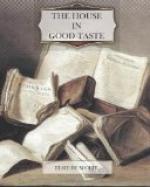The most delightful part of the drawing-room was the little conservatory, which was a plain, lamentable bay-window once upon a time. I determined to make a little flower-box of it, and had the floor of it paved with large tiles, and between the hardwood floor of the drawing-room and the marble of the window space was a narrow curb of marble, which made it possible to have a jolly little fountain in the window. The fountain splashed away to its heart’s content, for there was a drain pipe under the curb. At the top of the windows there were shallow white boxes filled with trailing ivy that hung down and screened the glass, making the window as delightful to the passer-by without as to us within. There were several pots of rose-colored flowers standing in a prim row on the marble curb.
You see how much simpler it is to make the best of an old bay window than to build on a new conservatory. There are thousands of houses with windows like this one of ours, an unfortunate space of which no use is made. Sometimes there is a gilt table bearing a lofty jar, sometimes a timid effort at comfort—a sofa—but usually the bay window is sacred to its own devices, whatever they may be! Why not spend a few dollars and make it the most interesting part of the room by giving it a lot of vines and flowers and a small fountain? It isn’t at all an expensive thing to do.
From the drawing-room you entered the dining-room. This was a long room with beautifully spaced walls, a high ceiling, and quaint cupboards. The arrangement of the mirrors around the cupboards and doors was unusual and most decorative. This room was so beautiful in itself that I used very little color—but such color! We never tired of the gray and white and ivory color-scheme, the quiet atmosphere that made glorious the old Chinese carpet, with its rose-colored ground and blue-and-gold medallions and border. The large India-ink sketches set in the walls are originals by Mennoyer, the delightful Eighteenth Century artist who did the overdoors of the Petit Trianon.
The mirror-framed lighting fixtures I brought over from France. The dining-table too, was French, of a creamy ivory-painted wood. The chairs had insets of cane of a deeper tone. The recessed window-seat was covered with a soft velvet of a deep yellow, and there were as many little footstools beside the window-seat as there were chairs in the room. Doesn’t everyone long for a footstool at table?
I believe that everything in one’s house should be comfortable, but one’s bedroom must be more than comfortable: it must be intimate, personal, one’s secret garden, so to speak. It may be as simple as a convent cell and still have this quality of the personality of its occupant.
There are two things that are as important to me as the bed in the bedrooms that I furnish, and they are the little tables at the head of the bed, and the lounging chairs. The little table must hold a good reading light, well shaded, for who doesn’t like to read in bed? There must also be a clock, and there really should be a telephone. And the chaise-longue, or couch, as the case may be, should be both comfortable and beautiful. Who hasn’t longed for a comfortable place to snatch forty winks at midday?




